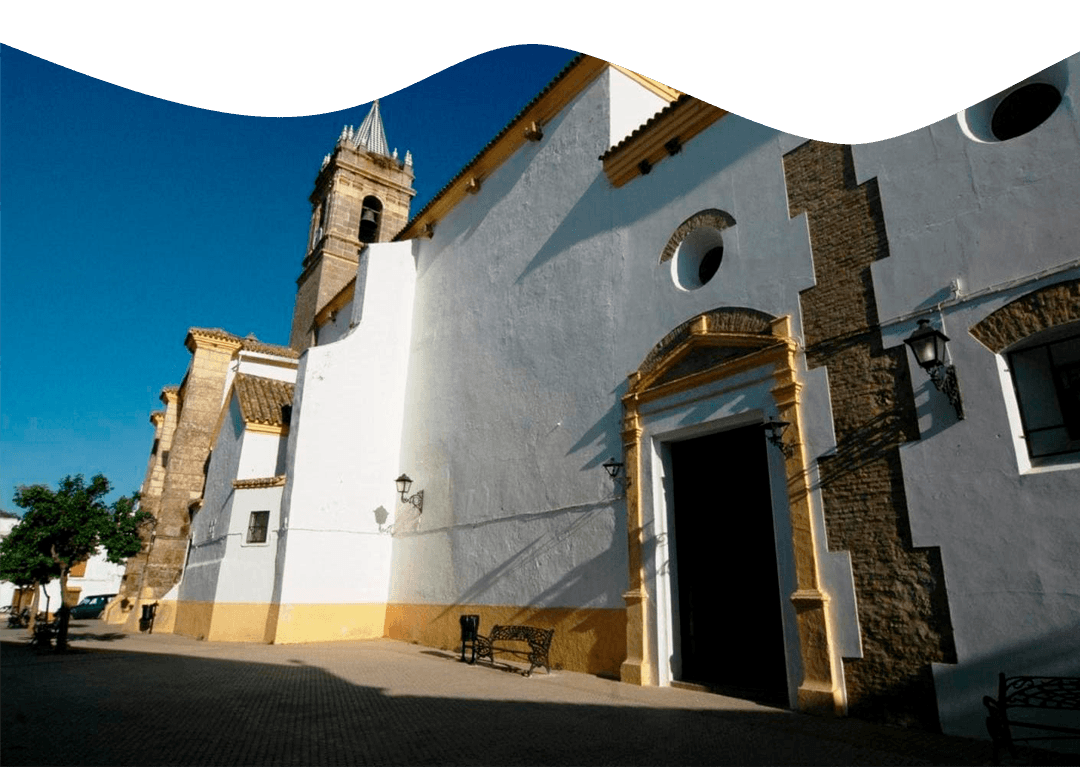New Schools Culture Center
Welcome to the Escuelas Nuevas Culture Center. Yours truly has the honor of accompanying you on this visit, my name is Francisco Antonio de Elorza. I was one of the pioneers in the steel industry in 19th century Spain. I managed the factories in Marbella and this beautiful town where we are located, El Pedroso.
This point where we are, the Cultural Center was once an important Muslim castle, given the height and strategic location of the enclave. This building was built to be a school in the 1930s and was inaugurated for the 1934/1935 academic year. At that time, boys and girls were still separated in education, so the place consisted of two doors and two floors. The boys studied upstairs and the girls studied downstairs. Luckily, everything has changed and we enjoy greater equality.
Although for you the place is old, at the time they naturally called it New Schools, and although it may seem strange to us, it is still the name by which we call this very special place, they called it that way because it was the first school in this town. Well, perhaps, it will always retain part of that initial freshness that is never lost. The architect of this work was D. Aurelio Gómez Millán, brother-in-law of Aníbal González, founder of the Plaza de España in Seville. It is not ruled out that the study of the building was his work, given the existing family relationship.
But many years have passed... And the school has now become the cultural hub of El Pedroso, housing a beautiful museum where the history of mining is kept and transmitted in which this town had a privileged situation, humility aside. thanks to yours truly (laughs mischievously). And on the other hand, the museum has also been dedicated to the history of writing, in homage to the school it once was. And also of course an entire room has been dedicated to the founder of the enormous Planeta publishing house, favorite son of El Pedroso, José Manuel Lara Hernández.
As you will see, culture, heritage and history go hand in hand in this unique temple of knowledge and cornerstone of our beloved town. But, enough of the words, please come in and find out for yourselves.
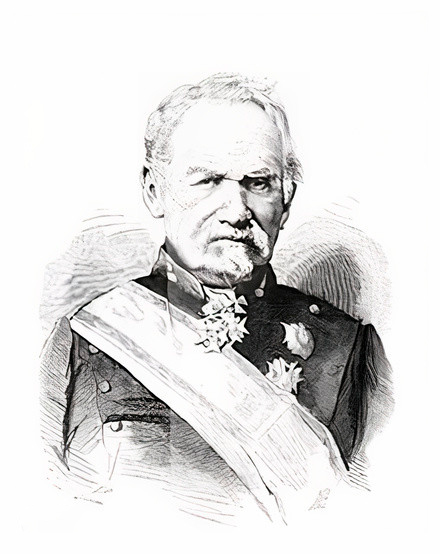

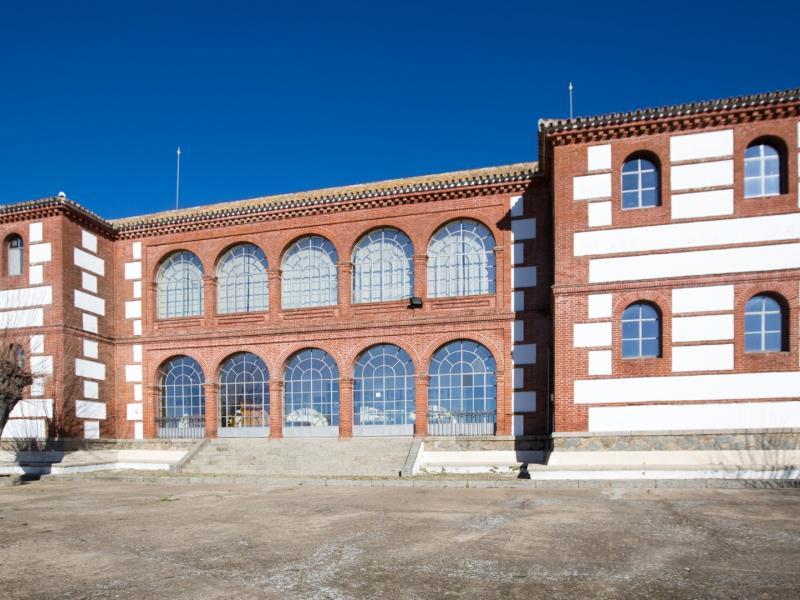
Walk me inside down the stairs
The access stairs to the museum, as we can see, are from granite, abundant stone in the area as we are in the batholith area. In case you didn't know, batholiths come from a large mass of eruptive rock, consolidated in the Earth's crust at great depth. But, well this is not a geology class, excuse me. In El Pedroso there have been granite quarries until about 20 years ago and a beautiful profession such as stone cutters. Along with mining, it is another important point of the economy in El Pedroso.

Gertrudis Gómez de Avellaneda Gallery
This hallway recognizes Gertrudis Gómez de Avellaneda Gallery, brilliant writer of romanticism and descendant of El Pedroso. His grandmother, Doña María Gil de Taboada, born in El Pedroso, married here with Don Manuel Gómez de Avellaneda, who was then councilor of the Villa de El Pedroso. Gertrudis was also the first among the writers of her time to declare against slavery, an action that led her to be a precursor of women's rights and the fight against social discrimination. Is it something to be proud of or not?

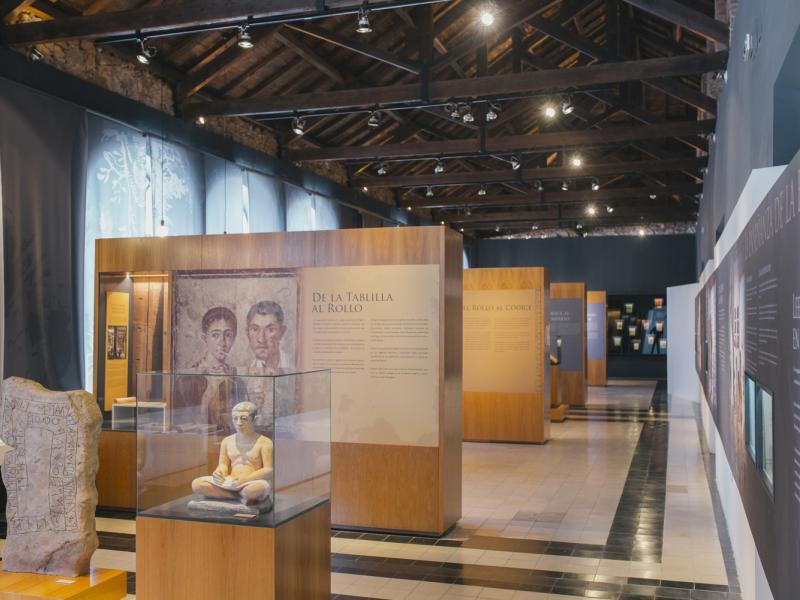
My room: the Ingeniero Elorza room
They have finally arrived! Does the name of this room sound familiar to you? That's how it is! Here the good people of El Pedroso honor me, Francisco Antonio de Elorza y Aguirre. In this town I assumed the technical direction of the steel industry in the 19th century and here the great importance that mining had from its Roman origins to your recent past is recounted.

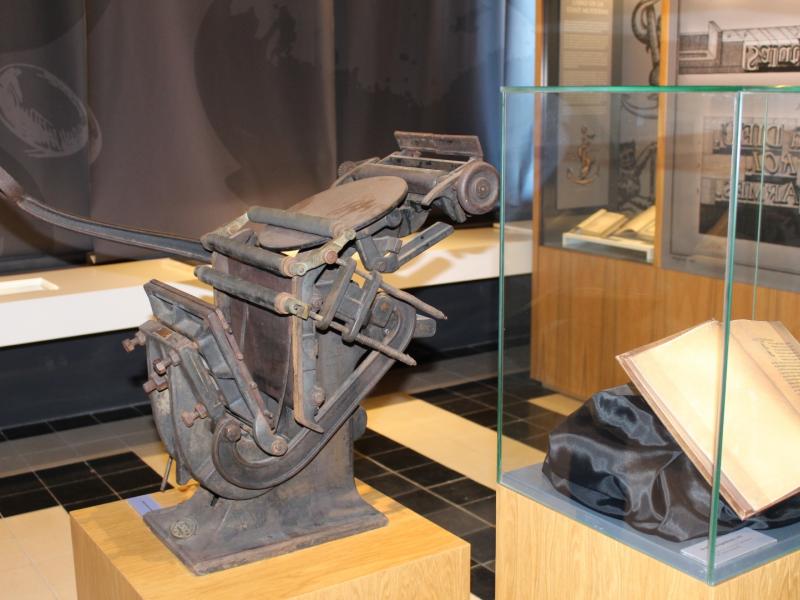
Ingeniero Elorza Room: the Blackboard
The room is a reproduction of a classroom in times of the Republic. Just as they were when the school was built. At the end of the class, each of the rulers of Spain while the building was a school appears framed on the blackboard like a giant book, these were, of course, Niceto Alcalá Zamora, Manuel Azaña, Francisco Franco and King Juan Carlos I. The old wooden desks are also recreated in the room, the interior of which is used to disseminate features of our history.

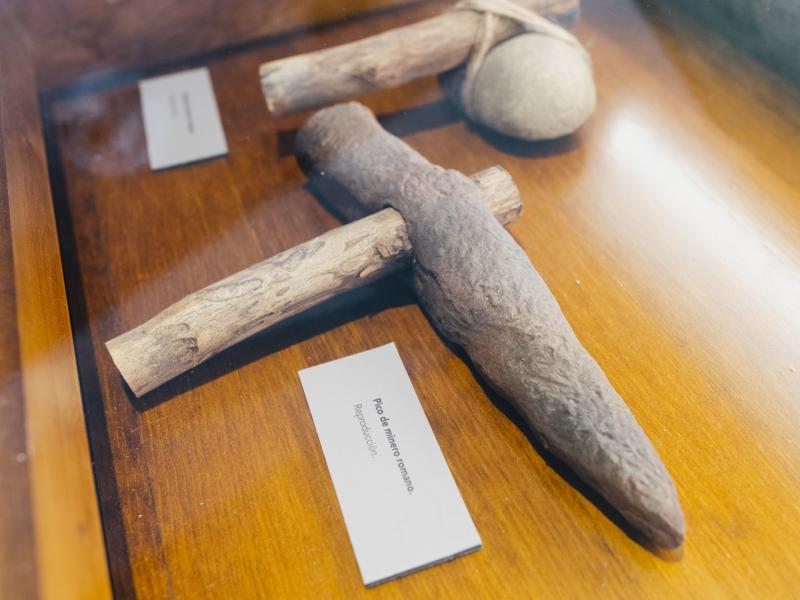
Elorza Engineer Room: Piedra Porrilla
Behold! Here we can see a batholith, which we talked about previously. The people of Pedro know it as “piedra porrilla”. Don't ask me why. It has the characteristic composition of granite made up of quartz, feldspar, orthose and mica. Many important buildings in this town are built with this type of stone, such as the Cruz del Humilladero, the feet of the street lamps or the typical water basins that can be found in some of our streets.

Elorza Engineer Room: Mulva-Munigua
The entire geographical area of El Pedroso began to be exploited to extract copper ore at the beginning of the Roman Era, in the city of Mulva-Munigua, whose ruins are located in the Villanueva del Río-Minas region. Later they also began to extract iron from the Pedrosa mines.

Ingeniero Elorza Room: history of the blast furnaces
Throughout this panel the history of the El Pedroso blast furnaces is told in detail.
In 1817, a mining-metallurgy company was launched, the El Pedroso Mines Company. It was made up of 12 partners from Seville and Cádiz who invested their money to make iron in the mines. Fourteen years since the beginning of activity, the mines were not profitable and had great losses. Due to the inexperience and ignorance that these people had in the world of the steel industry. So they decided to hire me, Francisco Antonio de Elorza, who at that time was already a renowned engineer with a lot of experience in steel operations. Thanks to the time I lived abroad I was able to acquire much more modern and effective knowledge.
I came from the north of Spain and restructured the entire system, expanding the facilities and giving rise to the most brilliant stage of the Pedrosa mines. Again, humility aside. I also bought new land and was in charge of establishing a kind of city with daycare centers, gardens, machinery, and roads for the almost 500 workers who made a living from my company. even bringing in highly qualified foreign labor.
From 1841 the El Pedroso iron factory He received numerous awards in our country and abroad in cities such as Paris, Vienna, London or Philadelphia. It reached such importance that great works such as the Eiffel Tower and the Crane of the Port of Seville, the Isabel II bridge (known as the Triana bridge) and the bars of the University of Geography and History of Seville (former factory of tobacco) were built with iron from the El Pedroso mines.
Then, in 1844 the factory entered its first crisis due to the lack of means of transportation such as the railway, since coal from the north was very competitive in price and we began to not be able to afford to buy it. In this fateful year I was forced to leave the El Pedroso factory and go to Asturias where another project awaited me. I abandoned the El Pedroso factory and in 1850 the factory went bankrupt.
However, later, In 1874 the first railway line arrived in the town covering the Seville-Mérida line, promoting activity again with it. Even in 1882 the factory launched a new product called “Limas de El Pedroso” whose quality steel achieved great fame in national and international markets.
But it was not until ten years later in 1884 when the train stopped at the El Pedroso factory, so the problem still existed and when it arrived it was too late.
The exciting history of this factory comes to an end in 1922 when engineer César Serrano tries to revive the old steel facility without success. The El Pedroso Iron Factory would never turn on its blast furnaces again. But its history, like so many others, full of successes and vicissitudes, will always remain in the footprint of the heritage of this town of ours.

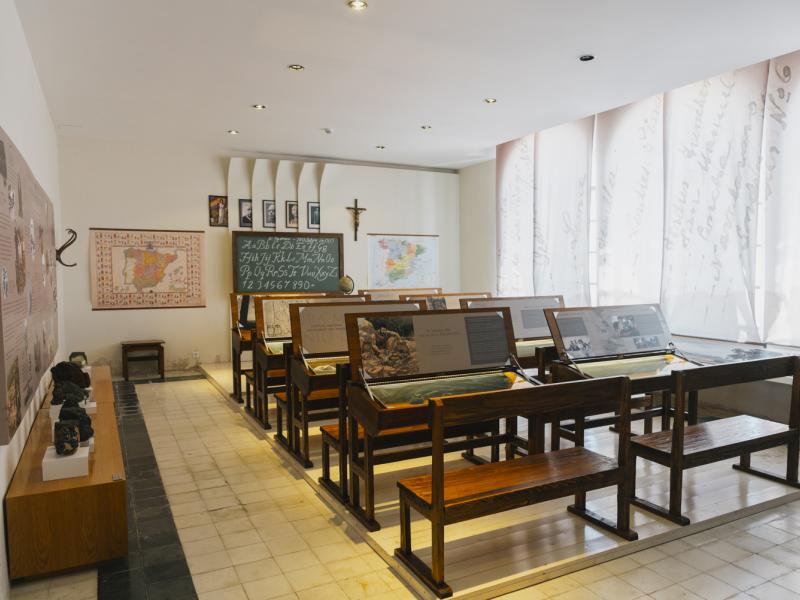
Elorza Engineer Room: windows
An old document from my time is projected onto these paper curtains, reflecting the names of the old mines in the area. A little further down you can see a panoramic view of El Pedroso and old photographs of the excavations. What memories!

Engineer Elorza Room: the desks
Now take a good look at the desks, where notebooks and pencils were once kept, pieces of the historical mining heritage of El Pedroso are now preserved as in a timeless museum. We can see the slag that was obtained when smelting the iron, as well as the most important minerals from which we obtained the iron, magnetite, hematite oligists and pyrites can be seen in this room and I can almost smell the steam from the factory...
Also on another of the desks we can contemplate the first contracts that were signed in Spain to protect workers of an iron factory. I made them myself, Francisco de Elorza, so that my employees could have a safe and dignified life in this difficult industry. They were very demanding tasks and it was not convenient to work here for a long time, so the contracts were for a maximum of five years. My company of course provided all means of transportation and accommodation for these workers and their families.
Look, on that other desk are some of the files that we produced in the factory and that became internationally famous for the quality of the iron with which they were built and whose sale would help the economy of this town in times of crisis.
In the last desk, the picks used and made with iron from our mines to excavate and cut the granite stone are preserved, work carried out by hand by the stonecutters of El Pedroso, people qualified in this laborious trade.
On the other hand, part of this exhibition has been reserved to exhibit elements from long before your era, and even mine! We are talking about prehistory, when the exciting history of mining really begins. We can see very primitive molds used to make the first tools with molten metal, as well as weapons and other tools of prehistoric life. Look at these materials belonging to the Neolithic and Chalcolithic period that have been found in our area, and these others from the Roman era. When I worked and lived here I also saw them, so now we are united by the sight of these vestiges of our species' past. It is something to marvel at, of course.

I introduce you to the Museum of Writing
“Verba volant, scripta manent" Words fly, writings remain. The history of writing is the history of humanity's battle against time. When human beings discovered that they could preserve messages and information in the everlasting material world, they unknowingly began the most important journey in history. What is thought can be forgotten, what is said can be ignored but what is written survives everything.
Join me on this adventure through time, as the next room tells the incredible story of the origin of Scripture.

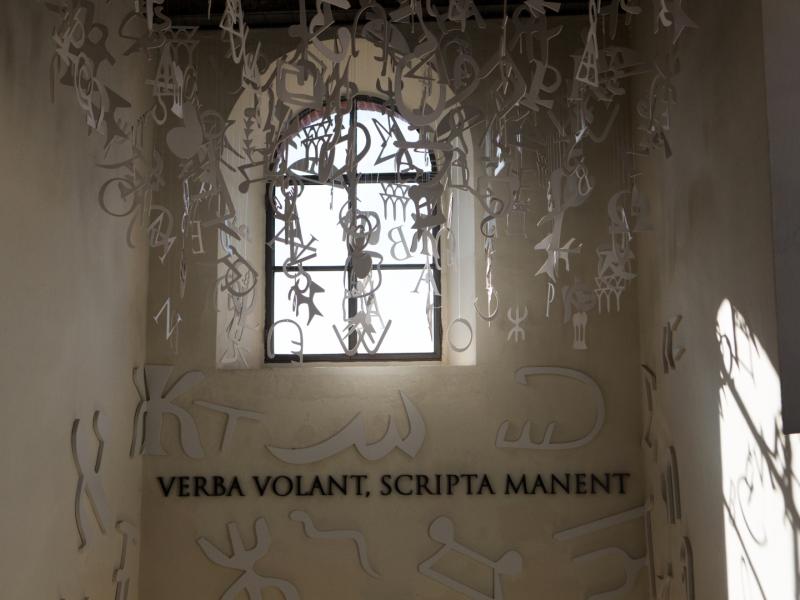
Writing Museum: the birth of writing
The beginning of this history, like that of civilization itself, is found in the great Mesopotamia. Fertile land between the Euphrates and Tigris rivers where so many peoples began the social evolution that has led us to where we are today.
The first Mesopotamians began to write on clay tablets with a wedge-shaped plant stem, being the first to invent a system to leave in writing what they believed to be important. We talk about cuneiform writing. They had a system of 700 signs in which they reflected concepts such as planting times, when animals gave birth, when they negotiated with other peoples, etc.
Later, the Egyptian civilization also devised a writing system that I'm sure you all know: hieroglyphics. These symbols written with colored inks of animal and mineral origin could represent between 700 and 6000 different concepts. We can often find them painted on walls, temples and pyramids; although they also invented the first type of paper: papyrus.
In the 2nd century BC, another very advanced people went one step further and created the first consonant alphabet made up of 22 letters, these are the Phoenicians. This first alphabet, formed only by consonants, has nothing to do with our current one, but its writing system does, from which the Chinese, Arabic and Roman writings also come. The Greeks later introduced vowels to the alphabets, bringing them even closer to those we know today, thus creating the complete alphabet.
Finally, of course, the Romans were implanting Latin throughout the European territory, unifying and universalizing the language and writing. In fact, as you know, all current Romance languages are variations of the same Latin origin. French, Italian, Romanian, Portuguese and of course Spanish come from Latin, as well as all the languages spoken in Spain with the exception of Basque, which is a pre-Roman language.
We must also highlight the Paleo-Iberian writing, long before the Romanization of our peninsula. We can date its beginning to the 7th century BC when the Iberian peoples were divided into two large groups: southern and northwestern. Where does the writing of the Tartessians come from, who used large stones called “trails“, writing in the form of a snail and still being undeciphered.
In the display case under the window, relics and examples of this long history are kept: These are, from left to right, clay tablets used by the Mesopotamians, bamboo stems with which they wrote on the tablets, paper made by from flax fiber, slate stone and a slate, examples of different resources from which the inks were obtained such as reeds for the color purple, soot for the color black, oak galls for the colors black and blue, cinnabar mineral for orange and red. And to finish, some examples that will sound familiar to you, such as pens and flash drives. And this story is still being written, every day with every new technology. And you are part of it.

Museum of Writing: from the tablet to the scroll
Let's see what's on the display in detail:
The Mesopotamian clay tablet: As we have mentioned, the first writings of humanity were not on paper but on mud and clay. With the help of the stylus, which is the fine utensil we see here, marks were made on the fresh bricks that, when dry, protected the writing from the passage of time. With the top of the stylus they would scratch on the brick when they made a mistake to write again, exactly like our modern pencils with their little erasers attached to the end! On wooden tablets smeared with beeswax, people wrote with the stylus, using the back part to erase what was written and leaving the page blank to write on it again.
Engraved stone scroll and turtle shell: Over time, clay was abandoned when a more comfortable medium was invented to write down what one thinks, the Egyptian papyrus or the first paper. This was easier to transport and less fragile. Imagine carrying all your notes in a piece of clay and having it fall to the ground and shatter... It is certainly not a tasteful dish. These papyri also usually measured between 6 and 10 meters, depending on the mold used to make them. On this paper you wrote on one side only.
This famous stone will sound familiar to you, right? That's right, it's about the Rosetta Stone. A recreation of this, of course, the original is in the British Museum in London. We are faced with a unique object, since on the relatively small surface of this stone there is the same Egyptian text translated into three different languages: the original in hieroglyphics, in demotic writing and in ancient Greek. Thanks to this archaeological discovery we have been able to decipher the written language of the hieroglyphs, with the help of comparative translation between the three languages. We could talk about a kind of Google Translate from the ancient era!
Let us now learn how papyrus was made. Imagine that we are on a cooking show. The first thing we need is the papyrus plant. One morning we approached the banks of the Nile where we have our plantation of this very special stem. We will cut a few and take them to the workshop. Once there we will cut it into very thin sheets and then intertwine them horizontally and vertically like a mesh. These meshes will be carefully hammered to impregnate them with each other and obtain a thicker paper. To finish, we will sand the surface and hydrate it with special resins and oils. All that remains is to roll it properly and that's it! we have our homemade papyrus roll. Human technology is exciting, right?
Look, in this tartessian stele We can see what Paleo-Iberian writing was like, whose translation we have been unable to deduce. Well, for now.
And who do we have here? Indeed it is the famous Seated Scribe, one of the most representative statues of the sculpture of the Old Kingdom of Egypt, and one of the most famous and well preserved of the entire Egyptian civilization. Again, this is an impeccable recreation since we would have to travel to Paris to see the original, in the Louvre Museum. The image naturally represents a scribe, those employees of the empire whose job was to write and copy the most important texts, most of them of a religious nature, which is why their texts were known as “writings for the gods.”

Did you know that the first legal code in history belongs to the Mesopotamian era?
I will secretly tell you some curiosities about this era of writing.
That's right, the well-known Code of Hammurabi, dated 1692 BC, was carved in cuneiform writing, which you already know. In addition, the monarch, Hammurabi, was graphically represented standing in front of the god Shamash, who according to Babylonian mythology delivered these laws of divine origin to the king. I am sure that this code is familiar to you because of the name of the Law of Talion, more commonly known by the motto “An eye for an eye and a tooth for a tooth”. Although this was only one of the 282 laws proposed by Hammurabi's empire and that were carved on this large basalt stele 2.25 meters high. A milestone in the history of laws and writing.
Did you know that the Epic of Gilgamesh is the first surviving epic poem in history?
Written around 2,500 BC and made up of 3,500 verses, it tells the adventure of the semi-mythical king Gilgamesh and his search for immortality. This hero will travel to the underworld in search of the plant that grants eternal youth, but when he returns with it, a snake snatches it away, losing it forever. However, the moral of this story, probably the oldest of humanity, is that it is useless to aspire to immortality when what is truly important is the life we have every day and knowing how to enjoy it.
Did you know that the Book of the Dead is a fundamental hieroglyphic text of Egyptian writing?
It belongs to 1550 and is considered the first published book in history. It explains magical formulas to help the deceased on their journey to the afterlife.

Museum of Writing: from the scroll to the codex, the Middle Ages
We are making great strides in this journey through time and history. We are now in the Middle Ages, when one of the great milestones in the technological evolution of writing occurred, we are talking about the transition from the papyrus roll to the parchment or codex. The latter was created from the skin of animals raised in the monasteries where they were manufactured. Mainly calf, lamb and goat skins were used.
In these monasteries the noble art of calligraphy and illustration. The inks used were made by mixing minerals, charcoal, water and gum arabic; obtaining vivid colors and with which they made these works of art. In the Middle Ages, the monastery became the cradle of the transmission of culture.

Do you want to know how these scrolls were made? Pay attention well. First, the skin of the animal was obtained and it was immersed in a bath of water with lime for ten days and ten nights. This skin was then scraped to remove impurities and placed on a rack to dry and tighten. Once dry, it was cut into small parts that now constituted the pages of the codex on which they could begin to write. The most precious codices were kept in leather cases.
Look, in the center of the room we can find a scriptorium, where scribes spent most of their time working often outdoors.
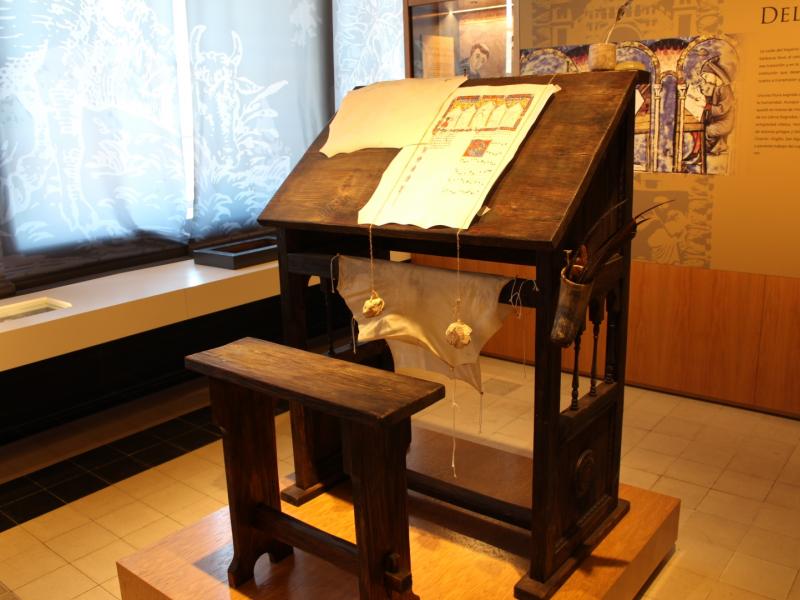
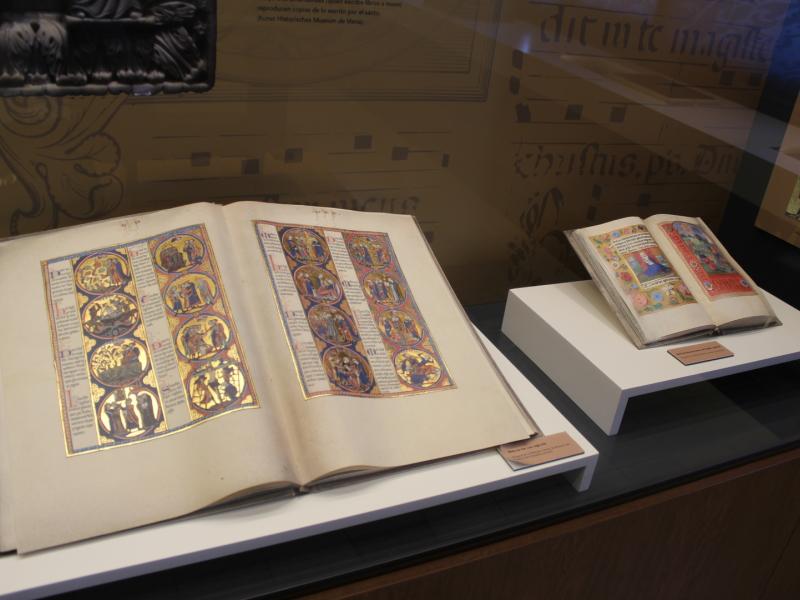
Did you know that the Dove Necklace is considered the most beautiful book about love in the Arabic language?
It dates back to 1023 AD, corresponding to the period of Muslim domination throughout the region that corresponded to Al-Andalus. At that time, the majority of the Andalusians knew how to read and write, which is why the writings that remain from this time are abundant. In fact, this book was one of the writings that were saved after the burning of profane books for Islam and has been translated into most European languages.
Did you know that the songs of Saint Mary are part of a medieval songbook in honor of the Virgin Mary illustrated with 40 miniatures?
His high quality paintings were made to be exhibited. It is considered a courtly book, which is how those writings made by the copyists who were in the service of the king are named. This work belongs to the reign of the illustrious Alfonso.

Museum of Writing from the codex to the printed book
As you know, probably the most relevant milestone in the history of writing was the invention of the printing press. The German invented it Johannes Gutenberg based on the mechanism of a dam to make wine. Steel punches were used and the metals were melted using matrices. Gutenberg began to make paper from flax fiber, which when macerated, pressed and washed, added starch and water to obtain paper pulp. Also important for this advance was the thickening of the ink that was spread with leather pads on the paper. Regarding the letters, called types, they were made with wood and metal. These were placed upside down as they worked as a negative whose subsequent print would be seen correctly. To achieve this they used a mirror to be able to place the types appropriately. Without a doubt, an invention that changed history forever.

Did you know that the first printers and publishers appeared in the 16th century?
The development of the printing press generated a large production of books. Aldo Manuzio He was one of the most important printers of the Italian Renaissance. He published the first books in pocket format that were characterized by the purity of their texts and the quality of the paper they used. They even had their own seal that they engraved on their publications and served as a certificate of a good book.
Did you know that the most relevant work of universal literature was published between the 17th and 18th centuries?
That's right, we talk about The Quijote. It is considered the first modern novel and tries to demystify the chivalric tradition. It is the most read book after the Bible, translated into 48 languages and this reach is also linked to the development of the Gutenberg printing press.
Did you know that Antonio de Nebrija was the first author to claim copyright in Spain and the Western world for his Latin and grammar dictionary published in 1494?

The center of this room
In the center of this room you can find a model of the printing press and the Aguilafuente Synod which was the first book printed in Spain and in Spanish in 1472.

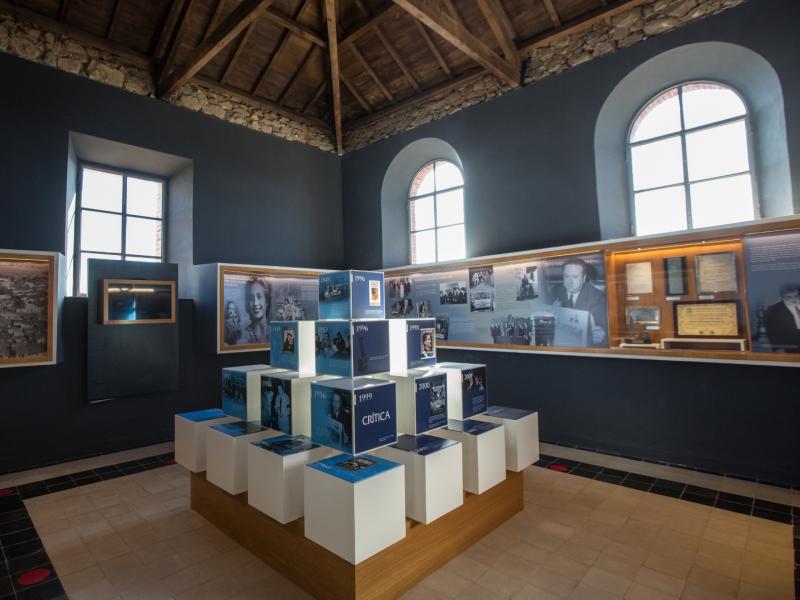
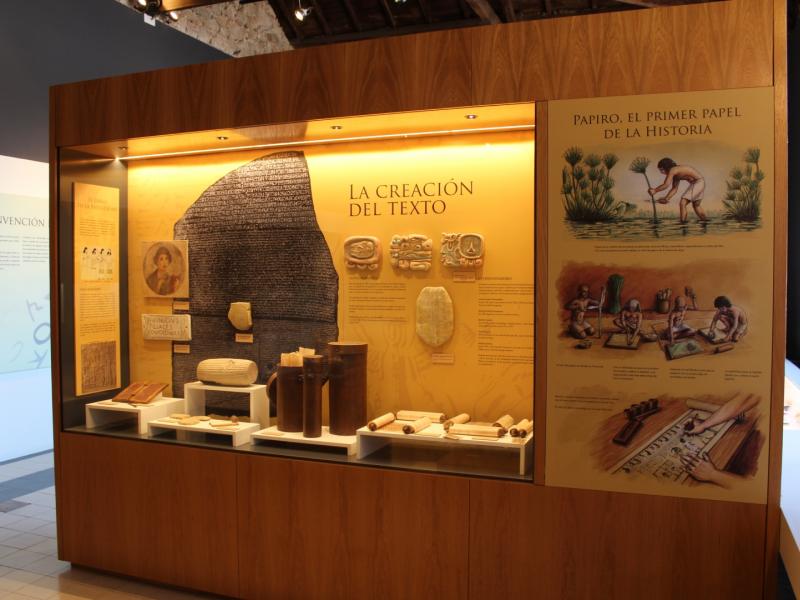
Museum of Writing: from the printed book to the digital book
History advances and with it technology. The printing press evolves year after year and with it books and magazines are published. At the same time, rotary machines allow the simultaneous printing of text and illustration. A little later, fountain pens and the typewriter were invented.

Did you know that in the 19th century, Lászo Moholy, a pioneer of graphic design, revolutionized typographic art and created a new language?
This focuses on the importance of the message and invents the typographic game of letters.
Did you know that Atanasoff Berry Computer (ABC) was the first automatic electronic and digital computer used with numbers and letters in 1942?
Did you know which Spanish writers received the Nobel Prize for Literature?
José Echegaray, Jacinto Benavente, Juan Ramón Jiménez, Vicente Alexandre and Camilo José Cela.

Writing Museum: Old School
This room is dedicated to the memory of the old school that this building once was. Everything we see on the displays are donations from former students of the school. We can see the reproduction of the shield of the Republic. On the door through which the boys entered the boys' coat of arms (national graduated school for boys) and on the door through which the girls entered the coat of arms of the girls (national girls' school).

The classroom throughout history
The essential space where teaching takes place is of course the classroom. This same room was one many years ago and we have all been through several throughout our student life. This important space has changed a lot from the origins of the culture to the present day. Along this wall you can see recreations of how it has evolved with each civilization. Shall we take a look?
In ancient Mesopotamia, the teaching of writing was carried out in schools called Houses of Tablets. These schools were rectangular with several rows of benches where up to four students sat. The schools had a kind of drawing teacher who was in charge of teaching the strokes of writing, a second teacher who taught them grammar, and someone in charge of instilling discipline with the use of a whip. Luckily now we use the power of education instead of pain.
In ancient Egypt, schools were called Instruction Houses. Those people who did not have knowledge were called slaves since education was very important. The school teacher was the scribe who was in charge of teaching the six subjects that existed: religion, music, language, hygiene, astronomy and writing. He went to school at the age of 6 years. At the end of the educational cycle they could take an exam, which if passed allowed them access to the School of Scribes where they were trained to be Pharaoh's officials.
In the Ancient Rome children go to Ludus Literarius, schools where primary education was taught. The manager was ludi magister who was in charge of teaching the first letters and numbers. From the age of 7, the father was in charge of the education of his children. At school, children learned to count, do accounts and memorize numbers with the help of an abacus or bead board. Spheres, geometric figures and maps were also used to teach mathematics and geography. Waxed tablets were used to write and small marble plaques that reproduced passages from ancient historical works were used to read.
In the Middle Ages Learning took place in the so-called Urban or Village Schools, where children learned to read, write and count. Education was free so that even the poorest could access it, education was reserved only for men. The teacher was usually a monk or cleric. Since the s. XII schools were established in the main cities and towns under the supervision of local authorities. The study was carried out from memory due to the high price of paper.
In the Modern age Education was poor and expensive; until the age of 6, children lived in a family environment. Between the ages of 6 and 14, children learned to read and write in their native language, to do simple operations and to memorize. Schools could have between 50 and 150 students, There was usually one teacher and two assistants, so individual attention was minimal. These cost money and the academic year lasted 11 months, so few families could afford to send their children to school. There were so-called “alms” students who could go to school without their parents having to pay.
In the so-called Century of the lights (Illustration) the importance of school education for the development of societies is emphasized. It is not until the reign of Charles III when one becomes aware of the pedagogical problem as a consequence of the great illiteracy that existed in the town. It constituted the education promoted by the state although that given by religious authorities had a more prepared teacher and with greater implementation.
In the middle of the s. XIX, the Piarists, the masters of the San Ildefonso Movement, real schools and innovative teachers, will give the learning of reading and writing in a more advanced concept. At the end of the s. XIX, the methodology is introduced by which, freeing the child from tedium and routine, they are trained by integrating play, becoming essential for the education of the senses in learning to read.

José Manuel Lara Hernández
This room is dedicated to José Manuel Lara Hernández, born in 1914 and who died in 2003. Was a Spanish editor and founder of the prestigious Editorial Planeta. He received the noble title of Marquis of Pedroso de Lara in 1994.


Planeta Awards Gallery
In this hallway we can find the Planeta awards gallery. Here the memory of all the books, authors and authors who have received the honor of being awarded this important prize for our literature is kept. The planet prize is awarded on October 15, which is Saint Teresa's Day in honor of José Manuel Lara's wife, María Teresa Bosh.

